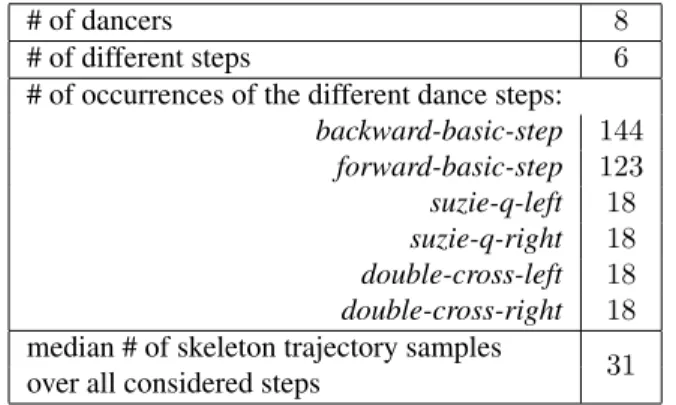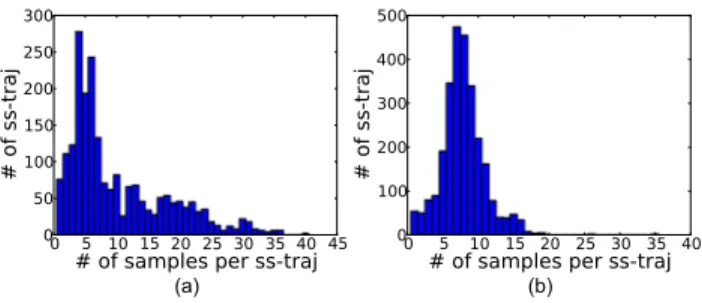HAL Id: hal-00904461
https://hal-imt.archives-ouvertes.fr/hal-00904461
Submitted on 14 Nov 2013
HAL is a multi-disciplinary open access
archive for the deposit and dissemination of
sci-entific research documents, whether they are
pub-lished or not. The documents may come from
teaching and research institutions in France or
abroad, or from public or private research centers.
L’archive ouverte pluridisciplinaire HAL, est
destinée au dépôt et à la diffusion de documents
scientifiques de niveau recherche, publiés ou non,
émanant des établissements d’enseignement et de
recherche français ou étrangers, des laboratoires
publics ou privés.
MULTIMODAL CLASSIFICATION OF DANCE
MOVEMENTS USING BODY JOINT
TRAJECTORIES AND STEP SOUNDS
Aymeric Masurelle, Slim Essid, Gael Richard
To cite this version:
Aymeric Masurelle, Slim Essid, Gael Richard. MULTIMODAL CLASSIFICATION OF DANCE
MOVEMENTS USING BODY JOINT TRAJECTORIES AND STEP SOUNDS. International
Work-shop on Image and Audio Analysis for Multimedia Interactive Services WIAMIS, Nov 2013, Paris,
France. pp.1-4, �10.1109/WIAMIS.2013.6616151�. �hal-00904461�
MULTIMODAL CLASSIFICATION OF DANCE MOVEMENTS
USING BODY JOINT TRAJECTORIES AND STEP SOUNDS
Aymeric Masurelle, Slim Essid and Ga¨el Richard
Institut Mines-T´el´ecom/T´el´ecom ParisTech, CNRS-LTCI, Paris, France
ABSTRACT
We present a multimodal approach to recognize isolated com-plex human body movements, namely Salsa dance steps. Our system exploits motion features extracted from 3D sub-trajec-tories of dancers’ body-joints (deduced from Kinect depth-map sequences) using principal component analysis (PCA). These sub-trajectories are obtained thanks to a footstep im-pact detection module (from recordings of piezoelectric sen-sors installed on the dance floor). Two alternative classifiers are tested with the resulting PCA features, namely Gaussian mixture models and hidden Markov models (HMM). Our ex-periments on a multimodal Salsa dataset show that our ap-proach is superior to a more traditionnal method. Using HMM classifiers with three hidden states, our system achieves a clas-sification performance of 74% in F-measure when recogniz-ing gestures among six possible classes, which outperforms the reference method by 11 percentage points.
1. INTRODUCTION
During the last few years, significant advances in human-computer interaction technologies have facilitated the multi-modal recording of spatio-temporal features of human body with the advent of devices such as the Wiimote, the Kinect, the Leap, etc. In parallel, gesture recognition has been an im-portant research area, mainly in the computer vision commu-nity [1]. On the one hand using RGB-cameras or depth sen-sors, different gesture recognition systems based on shape or appearance features have shown their efficiency [1]. Follow-ing the idea that human body movements can be evoked us-ing the motion of bright spots placed at main body joints [2], Bashir et al propose an original approach for gesture recogni-tion. They use a representation formed by a temporal-segmen-tation of 2D hand trajectories to perform a sign language clas-sification task [3]. On the other hand a few works have fol-lowed multimodal approaches. For example, for the analy-sis of traditional Japanese dance performances, Shiratori et al [4] combine a segmentation deduced from music beat infor-mation and a heuristic method for detecting key poses from speed data of a performer’s hand, feet and center of mass. Our work builds upon ideas developed in those previous con-tributions [3, 4] as we address the recognition of Salsa dance
steps. Our system relies on a novel multimodal represen-tation exploiting trajectories of dancers’ 3D body joint po-sitions (estimated from depthmap sequences) and an origi-nal segmentation technique segmenting those trajectories into sub-trajectories. The sub-trajectories are defined on instants where dancers’ footstep impacts happen on the floor (detected from signals of piezoelectric sensors installed on the floor [5]). Then the classification of dance gestures is achieved by hidden Markov models (HMM) classifier using principal component analysis (PCA) to represent efficiently those sub-trajectories [3].
The paper is organised as follows: a presentation of our Salsa dance step recognition process is given in Section 2. Then details and results from the evaluation stage are exposed and discussed in Section 3. Some conclusions are then suggested in Section 4.
2. METHOD
In this section, we first present the data acquisition (e.g. the acquisition of body joint trajectories and temporal locations of footstep impacts on the floor). The different stages of the mo-tion feature extracmo-tion are then explained. Finally the model-based classification is briefly described.
This system is a direct adaptation of the model developped by Bashir et al. for sign language recognition [3] to the prob-lem of dance gesture recognition and improves it by exploit-ing footstep impact detection in order to segment the global motion trajectories. This yields an enhanced motion repre-sentation amenable to an effective dynamic classification by HMM.
A global view of this approach has been summed up through a bloc diagram in Figure 1.
2.1. Input data
Our system takes as input trajectories of 3D body joints and step-impact temporal locations. In order to obtain the trajec-tories of a dancer’s body joints, we extract his/her skeleton (15 body joints) from a depth-map sequence using OpenNI1.
For detecting footstep impact instants, we re-use a technique
proposed by Essid et al [6]. From the signals captured by four onfloor piezoelectric tranducers, onset detection functions are extracted. Then those extracted features feed a one-class sup-port vector machine (SVM). Finally the SVM output values which are below a certain threshold are considered to be indi-cators of footstep impact instants.
2.2. Motion feature extraction
The motion feature extraction is done through three steps: tra-jectory segmentation, sub-tratra-jectory representation and PCA-based sub-trajectory representation, which are further detailed below.
Trajectory segmentation
For segmenting 3D body joint trajectories into sub-trajectories, we simply use the footstep impact locations obtained as seg-mentation points for all considered body joint trajectories. We aim at segmenting these trajectories into elementary ones to be associated to primitive motions from which local features are to be extracted. As explained by Shiratori et al [4], mu-sic beat information is an efficient cue for segmenting dance gestures into “primitive motions”. However, a dancer, espe-cially if he/she is not an experimented dancer, will not be ac-curately synchronized in time with the music. Hence a seg-mentation based on music beat locations cannot be expected to be fully reliable for segmenting the global motion trajecto-ries into primitive motions. In our case, a Salsa dance step is usually contained into a 4-beat music measure where the sec-ond, third and fourth beats are marked by footstep impacts. Thus we use footstep impact temporal locations as trajectory segmentation points which are inherent in dancers’ gestures instead of using the music beat locations.
Sub-trajectory representation
In order to encourage a scale- and translation-invariant sub-trajectory representation, all considered sub-sub-trajectory coor-dinates (x,y,z) are centered and normalized as follows:
x′n = xn− xmin xmax− xmin yn′ = yn− ymin ymax− ymin zn′ = zn− zmin zmax− zmin (1) where (xn,yn,zn) and (x′n,y′n,z′n) are respectively the
origi-nal and normalized versions of a 3D body joint coordinates at the nth
instant of time. The maximum and minimum val-ues of those original coordinates are deduced over all sub-trajectories of the current training set.
PCA-based motion feature
Following [3], a PCA-based representation is used to extract motion features from the resulting sub-trajectories. Firstly all
segmentation re-sampling PCA transform model-based recognition body joints' trajectory subtrajectories re-sampled subtrajectories motion features recognized dance step
Fig. 1. Schematic illustration of our Salsa dance step recognition approach.
those sub-trajectories are re-sampled to the median segment size of all training sub-trajectories. Secondly all considered joint coordinates from each re-sampled sub-trajectories are concatenated to form raw data vectors. Then from these sub-trajectory vectors the motion features are obtained by project-ing them on a set of eigen vectors derived from a PCA.
2.3. Model-based classification
To perform the gesture recognition task, two kinds of model-based classifiers are investigated: Gaussian mixture models (GMM) which are commonly used to estimate static prob-ability models and ergodic continuous density HMM which extend GMM to model temporal variations [7].
A model-based classifier is associated to each dance gesture class. Its hyper-parameters are learnt using the EM algorithm. Then test trajectories are categorized into one of the consid-ered gesture classes using maximum likelihood decision. The implementation of the considered algorithms has been done using a machine learning toolbox called Scikit-learn [8].
3. EXPERIMENTAL EVALUATION
In this section, we describe the dataset used, the evaluation protocol and the results obtained compared to the reference system proposed by Bashir et al. [3].
−200 0 200 2600 2800 3000 3200 −800 −600 −400 −200 0 200 400 600 800 −200 0 200 2600 2800 3000 3200 −800 −600 −400 −200 0 200 400 600 800 −200 0 200 2600 2800 3000 3200 −800 −600 −400 −200 0 200 400 600 800
Fig. 2.15 body joint skeleton representations obtained with OpenNI at three different time instants of a choreography performed by one dancer from the 3DLife dance database [5]. (The joints in red color are the ones we use in our system.)
3.1. Dataset
To evaluate our system, a subset of the 3DLife dance database [5] is used. This database is composed of multimodal record-ings of Salsa choreographies performed by several dancers.In addition to these recordings complementary files including synchronization delays for each media, and dance step an-notations related to each music choreography are attached. For classifier training and evaluation purposes, a ground-truth annotation of dance movements executed at every time instant has been performed, with a temporal precision of one musical beat (the beat information being given along with the annota-tions provided with the 3DLife dataset).
In Table 1, the statistics of the considered dataset we use are detailed.
# of dancers 8
# of different steps 6
# of occurrences of the different dance steps: backward-basic-step 144 forward-basic-step 123 suzie-q-left 18 suzie-q-right 18 double-cross-left 18 double-cross-right 18 median # of skeleton trajectory samples 31 over all considered steps
Table 1. Statistics of the considered dataset to evaluate the perfor-mance of the presented algorithms.
The selected Salsa steps for this evaluation are essentially characterized by legs movements. Thus to reduce the problem dimensionality, only six joints are used (ankle left/right, knee left/right and hip left/right), see Figure 2.
More details about the entire 3DLife dance database can
be found in [5].
3.2. Dance step classification 3.2.1. Evaluation procedure
Our evaluation is performed using cross-validation. To avoid using dance steps performed by a particular dancer both in the test and train partition through the same fold, the train and test partitions for each cross-validation fold are formed in a leave-one-dancer-out fashion. Thus the number of folds is equal to the number of dancers, that is eight.
For the GMM, the effect of the number of Gaussian mix-tures has been investigated (M ={2, 3, 4, 5, 6, 7, 8}). In the HMM implementation, we use one Gaussian probability den-sity function per hidden state and different hidden state num-bers are tested (Q ={2, 3, 4, 5, 6, 7, 8}). To deal with the di-mension of the feature vector, Bashir et al propose to choose the set of the most significant PCA components represent-ing 95% of the variance-information rate. Usrepresent-ing this infor-mation rate, we observed that in most cases only 4 or 5 (de-pending on the segmentation technique employed) of the 84 principal components are kept. We also test the values of the following set for the PCA-feature space dimension, d: {10, 20, 40, 60, 80}.
3.2.2. Classification results
In Table 2, we present the best results in F-measure obtained over all model parameters and feature space dimensions tested for our system compared to a reference one that consists in a direct adaptation of [3]. GMM HMM Bashir 61% 63% (M=6, d=80) (Q=4, d=40) Proposed 68% 74% (M=4, d=40) (Q=3, d=60)
Table 2. Best classification results (with 6 body joints) in F-measure on 6 Salsa steps with GMM and HMM classifiers.
The results of Table 2 show that our method obtains supe-rior performance compared to the reference system for both GMM and HMM classifiers. The improvement becomes very clear when using HMM.
When we compare the results obtained with GMM and HMM, an increase in the performance is observed for both methods separately. Actually for the approach proposed by Bashir et al [3], the increase is about 2 percentage points whereas for ours, the improvement is much bigger, about 6 percentage points. As we considered a trajectory as a sequence of sub-trajectories represented by motion features, the need for mod-eling temporal dependence among those features using HMM is confirmed, especially for our method.
0 5 10 15 20 25 30 35 40 45
# of samples per ss-traj
0 50 100 150 200 250 300 # o f s s-tra j (a) 0 5 10 15 20 25 30 35 40
# of samples per ss-traj
0 100 200 300 400 500 # o f s s-tra j (b)
Fig. 3. Sub-trajectory size (in sample number) histograms using Bashir et al’s segmentation technique, (a), and ours , (b), for the six different Salsa dance steps.
Comparing the difference between the performance increase for the two considered approaches, our segmentation tech-nique is more appropriate. To study this point, histograms of the sub-trajectory sizes in sample number are given in Figure 3. These histograms show that sub-trajectories obtained with our segmentation method have a length distribution much more compact than using the technique proposed by Bashir et al [3]. This means that our segmentation technique allows for a bet-ter consistency of the sub-trajectory sizes.
Thus using our technique to segment trajectories, HMM clas-sifiers manage to take advantage of the temporal dependen-cies between sub-trajectories which justifies the use of our segmentation approach.
4. CONCLUSION
Through this paper we have presented a new multimodal dance gesture classification system. Our approach takes advantage of an original temporal-segmentation method of 3D body joint trajectories based on footstep impact detections which allows an efficient representation of motion features. The efficiency of our segmentation technique is highlighted when the tempo-ral dependencies between adjacent sub-trajectories are mod-eled by HMM. Using those latters, our approach outperforms by 6 percentage points systems based on GMM classifiers or/and using a segmentation technique based on sudden changes in trajectory curvatures. An important extension of our re-search would be to include complementary features and data from other media such as accelerometers and microphones.
5. ACKNOWLEDGEMENT
This research was supported by the European Commission under contract “FP7-287723 REVERIE”. Thanks to Ang´elique Dr´emeau for having been very helpful during the annotation of the Salsa dance step.
6. REFERENCES
[1] J.K. Aggarwal and M.S. Ryoo, “Human activity analysis: A review,” ACM Comput. Surv., vol. 43, no. 3, pp. 16:1– 16:43, Apr. 2011.
[2] G. Johansson, “Visual perception of biological motion and a model for its analysis,” Attention Perception Psy-chophysics, vol. 14, no. 2, pp. 201–211, 1973.
[3] F.I. Bashir, A.A. Khokhar, and D. Schonfeld, “Ob-ject tra“Ob-jectory-based activity classification and recogni-tion using hidden markov models.,” IEEE Transacrecogni-tions on Image Processing, vol. 16, no. 7, pp. 1912–1919, 2007.
[4] T. Shiratori, A. Nakazawa, and K. Ikeuchi, “Detecting dance motion structure through music analysis,” in Pro-ceedings of the Sixth IEEE international conference on automatic Face and Gesture Recognition, Washington, DC, USA, 2004, FGR’ 04, pp. 857–862, IEEE Computer Society.
[5] S. Essid, X. Lin, M. Gowing, G. Kordelas, A. Ak-say, P. Kelly, T. Fillon, Q. Zhang, A. Dielmann, V. Ki-tanovski, R. Tournemenne, A. Masurelle, E. Izquierdo, N.E. O’Connor, P. Daras, and G. Richard, “A multi-modal dance corpus for research into interaction between humans in virtual environments,” Journal on Multimodal User Interfaces, 2012.
[6] S. Essid, Y. Grenier, M. Maazaoui, G. Richard, and R. Tournemenne, “An audio-driven virtual dance-teaching assistant,” in Proceedings of the 19th ACM inter-national conference on Multimedia, New York, NY, USA, 2011, MM ’11, pp. 675–678, ACM.
[7] C.M. Bishop, Pattern Recognition and Machine Learn-ing, Springer, Secaucus, NJ, USA, 2006.
[8] F. Pedregosa, G. Varoquaux, A. Gramfort, V. Michel, B. Thirion, O. Grisel, M. Blondel, P. Prettenhofer, R. Weiss, V. Dubourg, J. Vanderplas, A. Passos, D. Cour-napeau, M. Brucher, M. Perrot, and ´E. Duchesnay, “Scikit-learn: Machine learning in python,” Journal of Machine Learning Research, Oct 2011.


